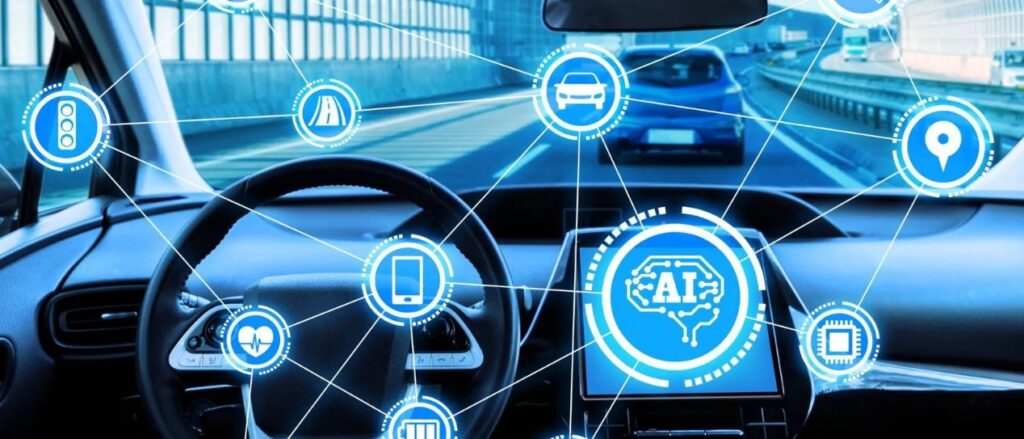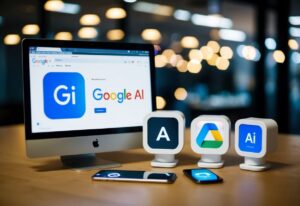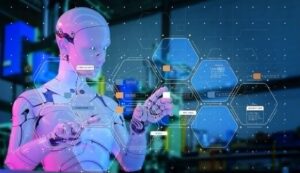AI in traffic management
How AI is Revolutionizing Traffic Management: Benefits, Examples, and Future Outlook.
Most of us encounter traffic congestion as an unavoidable part of daily life, but the impact goes far beyond frustration. Traffic congestion results in wasted time, increased air pollution, and higher fuel consumption, all of which cost billions globally each year.
As cities continue to grow, traditional traffic management systems struggle to keep up with the rising demand. Here’s where Artificial Intelligence (AI) is proving transformative. From dynamic traffic light systems to predictive analytics and autonomous public transport, AI is changing the way we manage and experience urban mobility.
In this post, we’ll take a detailed look at the role of AI in traffic management, the practical examples already in use, and the potential for a future where our streets are less congested, safer, and more eco-friendly.
Understanding AI in Traffic Management
What is AI in the Context of Traffic Management?
AI in traffic management leverages technologies such as machine learning, computer vision, and advanced data analytics to process real-time data collected from various sources. By using predictive modeling, AI algorithms can forecast traffic conditions, optimise traffic flow, and even respond to unexpected incidents. With this level of adaptability, AI-based systems outperform traditional traffic management, which typically relies on historical data or pre-set traffic light cycles that cannot adjust in real-time.
How AI Differs from Traditional Traffic Management
Traditional traffic management systems rely on fixed timing and schedules, which means they’re unable to adapt to sudden changes in traffic patterns, such as a major accident or a surge in vehicles. AI, on the other hand, is proactive. By gathering and analysing data from sensors, cameras, and connected vehicles, AI systems can make real-time adjustments to optimise traffic flow, prevent congestion, and reduce accident risks.
Key Benefits of AI in Traffic Management
Reduced Congestion
AI-driven traffic systems adapt traffic lights based on current traffic conditions, reducing wait times and alleviating congestion. Predictive analytics help reroute traffic in real-time, ensuring that vehicles flow smoothly even during peak hours. According to INRIX’s Global Traffic Scorecard, congestion can cost cities millions in lost productivity. AI is starting to turn that around by making the flow of vehicles more predictable.
Enhanced Road Safety
AI enhances road safety by detecting potential hazards and alerting drivers or authorities. For example, computer vision technology can detect accidents or stalled vehicles and alert emergency services automatically. This not only prevents secondary accidents but also shortens response times, potentially saving lives.
Lower Emissions
AI systems reduce idle times at traffic lights and help reroute vehicles to avoid congested areas, thereby lowering emissions. As engines idle less, air quality improves – a benefit for both the environment and public health. Studies by the International Council on Clean Transportation (ICCT) suggest that more efficient traffic flow could significantly reduce urban pollution levels.
Improved Commuter Experience
By providing optimised routes and real-time updates, AI-powered systems reduce commute times, making urban life more pleasant. With traffic apps like Google Maps and Waze (more on these below), commuters are constantly updated on the best routes and receive alerts about accidents or road closures.
AI in traffic managementReal-World Examples of AI in Traffic Management
1. Smart Traffic Lights in Pittsburgh, Pennsylvania
Pittsburgh’s implementation of AI-powered adaptive traffic lights has been a game-changer. This system, developed in collaboration with the Traffic21 Institute at Carnegie Mellon University Traffic21 Institute, utilises real-time data from sensors to adapt traffic signals based on vehicle flow. With AI algorithms calculating optimal light changes, the system has reduced traffic delays by 40% and cut down vehicle emissions by 26%.
- Technology: The system uses machine learning to analyse sensor data and adjust traffic lights.
- Impact: Significantly reduced delays and emissions, proving AI’s potential to improve urban traffic.
Takeaway: AI-driven adaptive traffic lights make traffic flow smoother, minimising delays and reducing environmental impact.
2. Real-Time Traffic Prediction with Google Maps and Waze
Google Maps and Waze use AI and machine learning to deliver real-time traffic predictions, rerouting users to avoid congested areas. By analysing data from millions of users worldwide, these apps predict traffic conditions, suggest the fastest routes, and help users save time on the road.
- Links: Google Maps | Waze
- Technology: AI algorithms, real-time data processing, and crowdsourced data.
- Impact: Time-saving routes and reduced overall congestion.
Takeaway: AI-based navigation apps like Google Maps and Waze significantly improve commuting experiences by offering efficient, real-time route suggestions.
3. IBM’s AI-Powered Traffic Management in the Netherlands
IBM has collaborated with several Dutch cities to develop AI-powered traffic management systems. These systems leverage IoT sensors, big data analytics, and AI-based predictive modeling to optimise traffic flow, detect accidents, and coordinate emergency responses. The Netherlands’ success with IBM’s Watson IoT platform (IBM Watson IoT) shows how AI can be applied to create smart, responsive traffic systems.
- Technology: IoT sensors, predictive analytics, and machine learning.
- Impact: Improved emergency response times, smoother traffic flow, and proactive congestion management.
Takeaway: IBM’s work in the Netherlands demonstrates the power of a coordinated, AI-driven approach to traffic management.
4. Computer Vision in Singapore for Smart Traffic Monitoring
Singapore’s traffic system uses AI-powered computer vision technology to monitor road conditions and detect violations in real-time. High-resolution cameras combined with AI algorithms enable the city to maintain a safer traffic environment by enforcing compliance and instantly detecting issues.
- Technology: Camera networks, computer vision, and machine learning.
- Impact: Reduction in accident rates and improved compliance with traffic laws.
Takeaway: Computer vision is an invaluable tool in AI-driven traffic management, offering real-time monitoring and automated enforcement capabilities.
5. Autonomous Public Transport Systems in China
China is at the forefront of autonomous public transport, particularly in cities like Shenzhen. The AI-driven Apollo platform by Baidu (Baidu Apollo), supports autonomous buses and cars, using machine learning to optimise routes and avoid collisions. This autonomous system is designed to provide a safer, more efficient, and scalable mode of public transport.
- Technology: Autonomous vehicle technology, AI algorithms, and machine learning.
- Impact: Improved efficiency and safety in public transport, reducing reliance on private vehicles.
Takeaway: Autonomous public transport is paving the way for a future where AI fully manages and optimises urban transportation systems.
Challenges and Limitations of AI in Traffic Management
Data Privacy
With data being collected from millions of devices, concerns over privacy and surveillance are valid. AI-driven traffic management systems need to maintain transparency and implement strict data protection protocols to retain public trust.
Infrastructure Costs
The upfront cost of setting up an AI-based traffic management system can be prohibitive, particularly in cities with limited budgets. The need for high-tech sensors, cameras, and reliable internet connectivity can make AI adoption challenging for some regions.
Adaptability Issues
Every city has unique traffic patterns, and adapting a universal AI system to fit diverse regions is a challenge. AI systems must be carefully calibrated to account for regional variations in traffic flow and road infrastructure.
Future of AI in Traffic Management
Predictive Analytics for Preventative Measures
As AI advances, we can expect systems capable of predicting traffic incidents before they occur. Predictive analytics could pre-emptively reroute vehicles, preventing congestion altogether. This would represent a shift from reactive to fully proactive traffic management.
Integration with Autonomous Vehicles
Future AI traffic management systems will work in tandem with autonomous vehicles, coordinating traffic flows that adapt in real-time to changing conditions. In this integrated future, autonomous cars and public transport will communicate with AI-driven traffic systems to maintain a seamless, intelligent urban transit network.
Expansion to Rural and Developing Areas
While AI-powered traffic solutions are often implemented in dense urban areas, expanding this technology to rural and developing regions would enhance global road safety and efficiency. Affordable, AI-based traffic solutions could make roads safer and more efficient on a global scale.
Conclusion
AI is reshaping traffic management in remarkable ways, making our cities safer, cleaner, and easier to navigate. From real-time route optimisation to predictive analytics and autonomous transportation, AI-driven traffic management systems promise a future where we spend less time in traffic and more time doing what we love.
With successful examples already in operation, like Pittsburgh’s adaptive traffic lights and IBM’s AI-powered systems in the Netherlands, the potential for AI to improve urban mobility is enormous. For city planners, engineers, and policymakers, adopting AI in traffic management is not just a technological upgrade – it’s a necessary step toward a sustainable and efficient urban future. The road ahead may be challenging, but AI offers a promising path forward.
Let’s embrace the future of traffic management and work toward a world with fewer traffic jams, safer roads, and healthier cities.



















